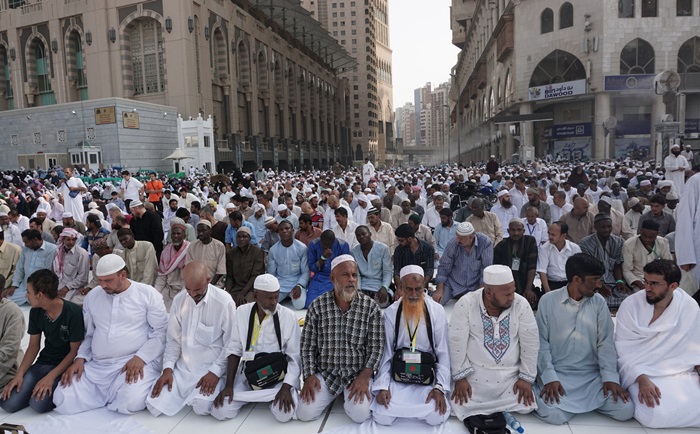: For long this ‘hajj subsidy’ has been used as a political tool : The duped Haji’s had been saving all their life for the ‘journey of a lifetime’ but were left robbed of not only their savings but also their spiritual hope :

Saadut
The Supreme Court recently asked the central government to do away with the government’s policy of giving subsidies to Hajj pilgrims and cease it totally within a period of 10 years. A Division Bench of Supreme Court further ruled “We hold that this policy is best done away with”.
For long the right winged forces in India have been targeting and criticizing the Hajj ‘subsidy’ as ‘Muslim appeasement’ but does the subsidy really exist? As per reports ‘The Centre at present foots an amount of Rs 38,000 per Haji by giving subsidized airfare’ (rediff May 08th 2012), but does the original airfare to the Holy cities even cost 38,000? A Hajj pilgrim pays around 26,000 for the fare while the government ‘claims’ to foot the remaining fare by a ‘subsidy’ amount to Air India. But a cursory look at the return fares from Delhi to Jeddah for Saudi Airlines, with a month or a forty day return gap shows an airfare of just Rs 25,725. If the actual fare is around 26,000 only what is the government paying this ‘subsidy’ over the 26,000 for? The government and the Hajj Committee has all along ensured that the air transportation monopoly for Hajj flights is maintained with Air India, while as private Hajj operators have been successful in managing competitive flight rates from other airlines for the same travel. So in effect this claimed ‘subsidy’ is being injected into Air India by inflating the price of air tickets at the cost of the gullible Hajis.
Had the government allowed a fare based competition for this holy trip, the air travel prices for Hajis would have been market regulated effectively removing the ‘subsidy’ component which in reality is the Air India monopoly cost.
Incidentally money is collected by the government from these pilgrims 5 to 6 months ahead of the travel and retained in the government accounts. With so much time available before departure, had there been open competition for offering flight services to these pilgrims, the fares could have been driven much lower than offered by Air India. Strangely a return ticket sold for 22,000 to 27,000 by other airlines, is charged for about 70,000 by Air India. What logic for the 70,000 fare? Rather than the government ‘subsidizing’ Hajj pilogrimage, it seems the pilgrims are being forced to add to the coffers of the financially weak Air India, pilgrimage becoming a scapegoat.
Not only are the pilgrims charged tickets at exorbitant rates by the government forced monopoly of Air India, there have been many questions raised about other facilities provided to these pilgrims and the cost charged thereof. Every Hajj pilgrim is charged about Rs 125,000 for the pilgrimage by the government, out of which a foreign currency of 2100 SR (amount equal to about 25,000 Rs) is returned to the pilgrim personal expenses. Deducting an amount of 26,000 which the government claims is only a part of the ‘subsidized’ ticket and the Saudi Riyal currency equivalent to almost 25,000 returned to the Hajji, we still are left with 74,000. Rented accommodation provided by the government to Hajis in Mecca and Medina costs another almost 54,000 (3500 SR in Mecca for almost a month stay and 1000 SR in Medina for a 10 day stay. Arafat and Muzdalifa are included in the Mecca stay). Pertinently there have been often complaints by Hajis that the stay in Mecca arranged by the government of India is too far from the holy sites and in no way having a prevalent market worth of 3500 SR for a shared accommodation of almost 6 pilgrims in one room. The preparation for booking accommodation at the two holy cities for Hajis starts months before the pilgrimage and the government has ample time to get good accommodation at reasonable prices, but more often than not each year Haji’s have been complaining about the condition and distances of these accommodations from the holy mosques. Such accusations apart even after paying the rentals of 54,000 per Haji (450 SR, 1 SR assumed = 12 INR), there should be a surplus pilgrim money of about 20,000 Rupees with the government. The government does not have to incur any via costs as the Saudi government does not charge anything for these visas. Since there are no other facilities of board & lodge provided by the government to pilgrims (all food has to be managed by pilgrims on their own), what does the government do with this money? Is this money (2000 x 11000 Hajjis = 220 million) ever accounted for in the din of ‘subsidized hajj’?
Every year the state governments nominate ‘Khadims’ (one who helps) to accompany Hajis, reportedly for serving the ‘Hajis’ and being their local reference point. Ironically most of these ‘nominated Khadims’ whose Hajj travel and stay is free of cost are political nominees or bureaucratic favorites and hardly available for helping the Haji’s during the pilgrimage. Even nominations for ‘doctors’ send on Hajj duty along with the pilgrims is mired in controversy, many a times the same ‘well connected’ person being nominated repeatedly. Clearly politics prevails even in this pilgrimage management.
The government of India also sends a huge ‘good will delegation’ during the Hajj, compromising of political nominees. This free trip obviously must be coming at the expense of the common Haji’s who sees no good will in such politicking. Incidentally the Supreme Court bench has also directed the government to reduce the number of representatives in the PM’s ‘good will’ delegation to two from the existing thirty.
While the government claimed ‘subsidized Hajj’ costs almost 125,000 for each pilgrim, there have been private operators who have been charging almost the same amount for the holy journey with better accommodation facilities and in many cases food included. While offering better facilities and with no ‘subsidized’ support, the private operators are still making money, thereby exposing the government in its ‘subsidized’ political appeasement drama. Clearly the government could learn how to manage ‘Hajj’ without its political baggage from these private players. But these private players are not without their risks, often because of lack of regulatory control and legal cover to the Hajj aspirants. One private operator, Hajeej India Pvt Ltd, some time back used this non regulated control to dupe hundreds of aspiring Haji’s from Kashmir by enrolling them for Hajj and the defrauding them of corores of rupees. Reportedly the management of ‘Hajeej India’ had been close to powerful offices in Kashmir having earlier managed to take senior state officials and politicians for the ‘Hajj pilgrimage’. The duped Haji’s had been saving all their life for the ‘journey of a lifetime’ but were left robbed of not only their savings but also their spiritual hope.
For long this ‘hajj subsidy’ has been used as a political tool, by the right winged parties as a weapon against Muslim minorities and by the centrist parties for Muslim vote appeasement, while as factually the Hajji (pilgrim) seems to be paying more than is due.
The government would do itself good by ensuring transparency in the Hajj process and its finances, without its political baggage and by shedding the ‘free flying government nominees’ nepotism. It could also ensure regulatory control of the private players involved in the Hajj pilgrimage, thereby freeing itself from the ‘political economics’ of Hajj. ( 2012 )


